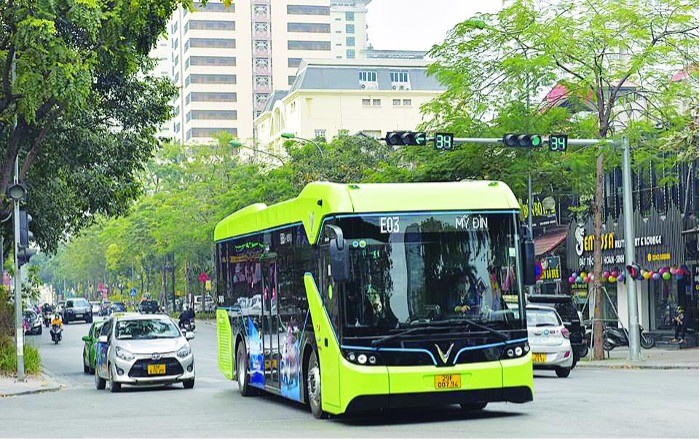 |
| An electric bus runs on route My Dinh - Ocean Park urban area in Hanoi.(Photo: Courtesy of the Ministry of Transport) |
The transport sector aims to gradually limit and stop the production, assembly and import of cars and motorbikes using fossil fuels by 2040. By 2050, all motor vehicles will use electricity and green energy. Therefore, developing charging stations is essential.
Electric vehicles are considered the transportation industry's future as people in big cities increasingly favour these units. Ministry of Transport statistics show that more than 20,000 electric cars were used nationwide last year.
However, charging stations on the roads are not enough to meet the needs of electric vehicles. The largest charging station system is of VinFast, with more than 150,000 ports for both motorbikes and cars. It is located in parking lots, bus stations, shopping centres, and gas stations. Besides these stations, people mainly charge their vehicles at home.
At a workshop on promoting energy transition and building policies to invest in charging stations in Vietnam organised by the United Nations Development Programme (UNDP), Prof. Dr. Wilmar Matinez, UNDP electric energy research expert, said that in Vietnam the concept of electric cars remains new.
The number of vehicles using green energy is still low compared to those using fossil fuels. This is also why electric charging stations on roads, especially highways, are less common than in other countries.
He believed the need for charging stations was one of the main reasons consumers hesitate to buy and use electric vehicles. The road traffic infrastructure development plan targets that by 2050, Vietnam will build more than 9,000 km of highways, nearly eight times more than the current number.
To Nam Toan, head of the Department of Environmental Science, Technology and International Cooperation under the Department for Roads of Vietnam, said that the Ministry of Transport is updating the highway network planning and would likely increase planned charging stations according to the request of localities.
Each highway is designed to have rest stops and, experts said, these would be suitable places to place charging stations for electric vehicles.
Wilmar Matinez said that with current electric technology, the battery usually allows the vehicle to travel about 180-300km per charge.
People who want to travel long distances need numerous charging stations to charge their vehicles while taking a break before continuing. If the country cannot solve the problem of charging stations, it won't be easy to achieve the goal of completely replacing gas and diesel vehicles with electric vehicles in the future. Therefore, the need for charging stations in Vietnam is very high.
Through practical research on developing electric vehicle charging stations in Thailand, Germany, Norway and the Republic of Korea, Wilmar said that building a network of charging stations requires strong Government and private sector engagement.
Germany has stepped up investment in research and expansion of charging stations through grants and research funds. People who buy new electric cars can receive incentives of up to 80% of the car price.
The above countries also have strict regulations in building charging infrastructure, standardising charging stations, sources, and speeds, and regulating public charging at home.
A study by UNDP experts shows that with 39 rest stations on the eastern North-South Expressway and assuming that by 2050, all vehicles on roads will be electric, it is necessary to invest in about 7,800 charging ports. Based on the investment rate this year, about 2.2 billion USD will be needed for 2025-2050. With this investment cost, Vietnam needs to encourage private organisations to contribute capital.
Incentives may include tax exemption for the first five years after the charging stations are operated and a 50% tax reduction for the next five years. The most important thing to attract private investment is accelerating the use of electric vehicles. The private sector must be allowed to collecting fees for charging services to recover capital.
Nguyen The Vinh, an expert from Electricity Vietnam, said that the number of charging stations was not the only issue. Increasing charging stations on highways requires calculating the number of vehicles and charging times at each station to avoid putting too much pressure on the electrical system nationwide, causing local power outages.
The public charging station system currently accounts for 10% of the country's power consumption.
Regarding this concern of the electricity industry, Nguyen Bao Huy, from the Hanoi University of Science and Technology, said that the country could apply a smart charging system.
This system uses remote monitoring technology to manage the car's charging time and method at each station; and provides data on available charging stations in the surrounding areas.
With this method, Vietnam can evenly distribute the number of vehicles at charging points, avoiding charging too many cars during peak hours, which could overload the system and cause power failure.


























